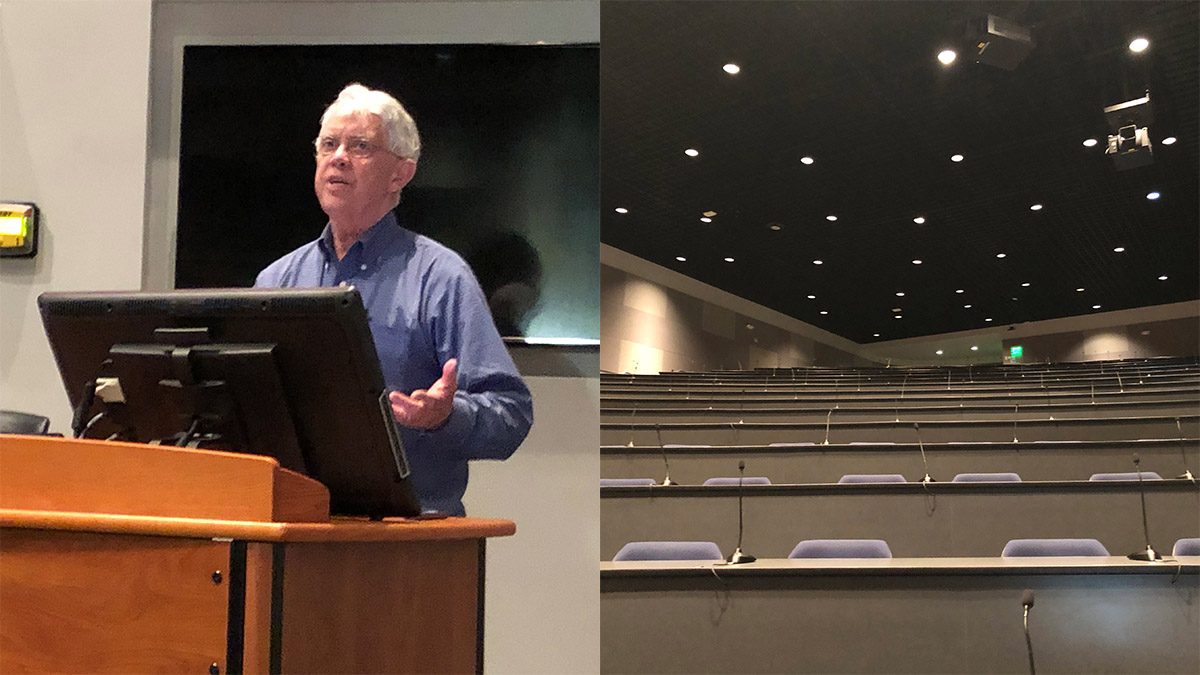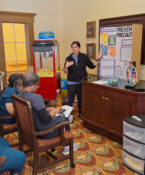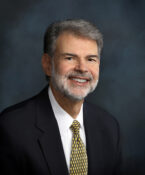The month medical education changed…possibly forever

It was late February, and COVID-19 was spreading globally. But the concern about the wide-reaching impacts it could have on every segment of American society was minimal. It was around that time that Dr. Michael Oglesby of the Texas College of Osteopathic Medicine, a sage of over 40 years of teaching, started to worry.
He emailed Ryan Seals, DO, TCOM’s Senior Associate Dean of Academic Affairs, and noted that the school was likely to face the crisis sooner, rather than later, and that they needed to prepare everyone. Faculty, staff and students.
But how do you do that? Year 1 and Year 2 students were on campus, while Year 3 and Year 4 were on clinical rotations and electives around the state.
What would take place over the next 30 days would transform the curriculum, training and education for over 900 medical students from in-person to remote and online. Nothing short of a Herculean effort would be required. Here is the story of how it happened.
The crisis is coming
Dr. Oglesby and Dr. Seals saw the potential tidal wave looming and started taking immediate action. They contacted HSC’s Center for Innovative Learning to schedule a presentation to Academy of Medical Educators faculty members as soon as possible.
On March 3, an email was sent to AME faculty urging their attendance and stressing the importance of this meeting. The next day, the room was packed. John McKenzie of the CIL made a presentation on distance-education tools, which was the vital foundation for faculty members to begin preparations for online teaching.
“The next nine days were some of the most demanding and rewarding that I’ve ever had the privilege to participate in,” Dr. Oglesby said.
There were three significant questions all of the faculty members had to address. What would they like to do? What was realistically possible? And how could they implement new technology with maximum probability of success?
The starting point was to extend the faculty’s knowledge of the use of interactive tools such as Zoom and Microsoft Teams to ensure that as many faculty as possible were well-trained in distance-education techniques. Over the next few days, faculty members would collaborate to understand the technology, but also how to weave it into their curriculum.
TCOM faculty members got a pleasant reprieve from the calendar. Spring Break was from March 9-13, giving them an extra week to prepare.
“Things really ramped up quickly during the week of Spring Break, and our anticipation of a shift to distance learning ramped up as well beginning on March 9,” said Dr. Michael Smith, TCOM’s Year 1 Director of Curriculum. “We were ahead of the curve. Our plans were in development one to two weeks before the state and institutional restrictions were imposed on gatherings.”
Cancel the rotations
At the same time, Dr. Frank Filipetto, TCOM Dean, saw another crisis looming on the horizon. The clinical rotations. TCOM Year 3 and Year 4 students were in hospitals all over the state.
TCOM’s Executive Director of Clinical Education Katy Kemp saw it, too. The week of March 2, Kemp coordinated with all students returning from international travel in adhering to the self-observation periods.
Dr. David Mason, TCOM’s Assistant Dean of Osteopathic Clinical Education, met with Kemp daily for updates. Kemp knew what was coming. She contacted several faculty members during Spring Break, starting March 9, to start considering online electives and how to implement them.
On March 13, Dr. Mason sent out a memo to all students following the guidelines from the American Association of Medical Colleges regarding student participation in clinical activities during the COVID-19 outbreak. Two days later, hospitals started asking students to leave.
On March 16, Dr. Filipetto made the difficult decision to move immediately all Core clinical rotations, regardless of site, to the online learning environment. Elective rotations were allowed to continue, site permitting. TCOM’s timing was perfect as local sites around DFW started pulling rotations at nearly the same time.
The students who were removed finished the last two weeks of their March rotations in the online environment. Starting March 30, all students began a new block, all in an online setting.
“Never before would I have thought that clinical rotations could achieve the same learning objectives without actual patient encounters,” Dr. Mason said. “However, we were actually providing a lot of cases and online videos already and found that there are many resources already in place.”
Year 3 and Year 4 students transitioned seamlessly, but hurdles still existed. New electives would need to be added to help supplement the loss of rotations, and they had to be done by March 30.
The TCOM faculty delivered.
“It was a lot of work, but everyone pitched in,” Dr. Mason said. “The electives were created by passionate educators who saw a need and amassed resources and built entire courses in a week.”
Dr. Mason is quick to credit the work by Kemp and her team of clerkship coordinators for organizing the clerkship directors, answering the flood of questions by students and keeping the rotations afloat.
“Katy deserves a High-5, but since we can’t do real High-5’s, it will have to be a virtual one,” Dr. Mason said.
Year 1 and Year 2
March 9, the first day of Spring Break for TCOM Year 1 and Year 2 students. While they were unwinding from their very rigorous schedules, TCOM faculty and staff were working feverously behind the scenes to move the curriculum to an online and distance education model.
Timing was critical.
“Due to our anticipation and preparation a few weeks in advance, when we entered the Spring Break period – when we knew we were likely headed to this major transition – I felt very confident that we would be prepared and make a relatively smooth transition,” Dr. Smith said.
Prophetic words. But it didn’t make the transition any easier. For Year 2 students, their training is three simultaneous courses, which consist of a systems course, a medical practice course and a professionalism and systems based-practice course. Working the logistics alone was a mountain of work, and it had to be done in days.
“I don’t know if I can adequately convey how well the medical education team worked,” Dr. Oglesby said. “Kudos to Amy Chambers, Ashton Whaley, Joycelyn Bryant, Tony Martinez, John McKenzie, Debbie Bauer, Dr. Smith and Dr. Seals. This team implemented the strategies we adopted.”
While the strategies were in place by March 16, the first day back from Spring Break, how would they conduct business? What piece of technology would they use? Between March 4 and March 18, the faculty and medical education team wrangled between Zoom, Microsoft Teams and Canvas Conversation. The team agreed to use Zoom for live meetings with the classes, and on March 18, they trained a small-groups faculty in a live session. One day later, the first live session with students was underway.
Along with using technology, many faculty members were able to record lectures for later use or have the students watch it live. On March 18, Dr. Monte Troutman gave a lecture to an empty MET 125 classroom, or so it seemed. His audience could watch his lecture at any time of the day now.
It has been a herculean effort, but our #TCOM faculty and staff have spent the last week shifting to an online curriculum to keep the top notch training going @TCOM_UNTHSC . Dr. Monte Troutman’s in person audience was sparse, but he didn’t seem to mind. #remoteosteopathictraining pic.twitter.com/cA8mfLnsYS
— TCOM UNTHSC (@TCOM_UNTHSC) March 18, 2020
One problem remained. How to conduct secure, remote testing?
“The other profound issue we faced was how to give examinations,” Dr. Oglesby said. “Year 1 was scheduled for an exam on March 26, and Year 2 on March 30. As late as March 16, it seemed a 50-50 bet we could use distancing strategies to get these in on campus. However, planning for the worst outcome, Testing Services did a marvelous job of assessing on-line testing tools to ensure exam integrity, and these two exam were given as scheduled, remotely.”
By the beginning of the week of March 30, the TCOM faculty and staff had done it. An entire curriculum, from Year 1 all the way through Year 4 students, had been shifted to remote, online and distance education.
Isolation Day… (fill in the blank) …#TCOM students are spread out all over the nation, but still locked into learning. Here is a small sampling of the variety of study spaces, journal clubs, tutoring, study groups and other inventive ways to keep the learning process moving. pic.twitter.com/JWi7lTMowJ
— TCOM UNTHSC (@TCOM_UNTHSC) March 24, 2020
“Drs. Oglesby and Smith were instrumental in guiding our teams through the transition to remote learning,” Dr. Seals said. “Their foresight and teamwork were pivotal to ensure that our students’ education proceeded with minimal disruptions. It was really encouraging to see everyone on our team pitching in working tirelessly to accomplish this feat.”
The Future of medical education
While the impact of COVID-19 still is being felt around the world, what will the pandemic’s potential legacy be on medical education when it subsides?
“I believe this is helping us better understand how distance learning can be used and will help us use it in the future to make education more efficient,” Dr. Smith said. “The majority of students prefer to study outside of the classroom, and this is altering the approaches of medical schools nationwide in the delivery of the core information and knowledge that is required.”
The foundational elements of what TCOM teaches, trains and preaches never lost their impact in the transition to remote and online learning. But everyone agrees there are important lessons to take away from the experience.
“I think we have learned that what we have been doing is good. But we have realized there are other great resources out there to use, and we need to focus on assessment of skills and behaviors more,” Dr. Mason said. “We have the medical knowledge pieces covered.”
While the potential changes to the educational system as a whole still aren’t clear, the technological prowess and muscle flexed by TCOM during the crisis has convinced Dr. Oglesby that it is prepared for whatever comes next.
“The model ‘information is hard to find and revealed by a wise sage’ is dead,” Dr. Oglesby said. “At your fingertips are everything you could want to know about a subject, so your local sage is a relic. I tend to be pretty radical in championing these ideas, but you can ask anyone about class attendance. Students are voting with their feet concerning the utility of live presence of a lecturer in a classroom.”
Some light reading, some #SocialDistance and a Mr. Potato head. It’s a new world for our osteopathic medical students, but they are persevering through thick and thin, and coming closer by being father apart. #TCOM #COVID19 #distancelearning pic.twitter.com/CCM1YTEN9Z
— TCOM UNTHSC (@TCOM_UNTHSC) March 24, 2020


![Uyen Sa Nguyen Scaled[58]](https://www.unthsc.edu/newsroom/wp-content/uploads/sites/16/Uyen-Sa-Nguyen-scaled58-145x175.jpg)


Social media